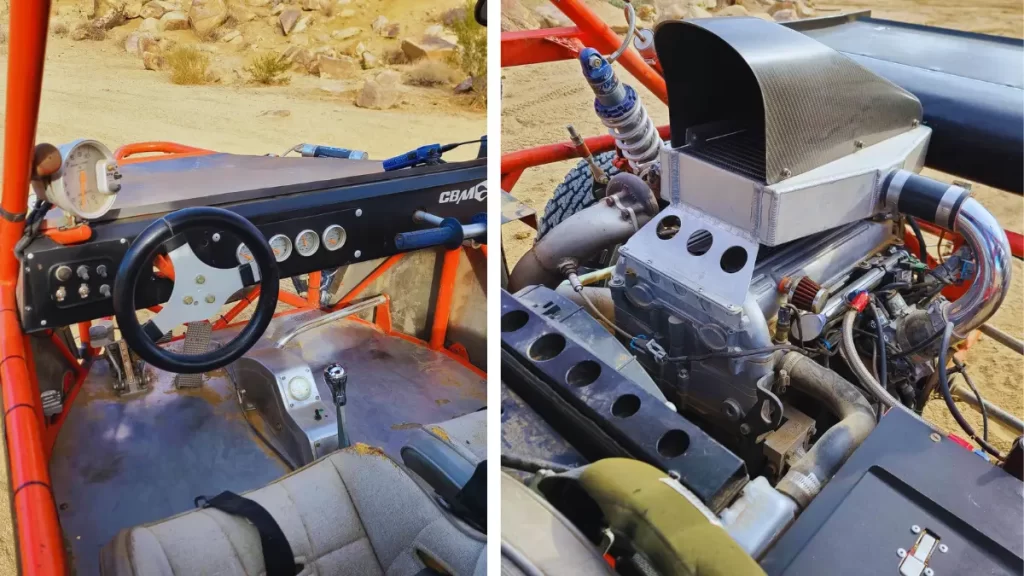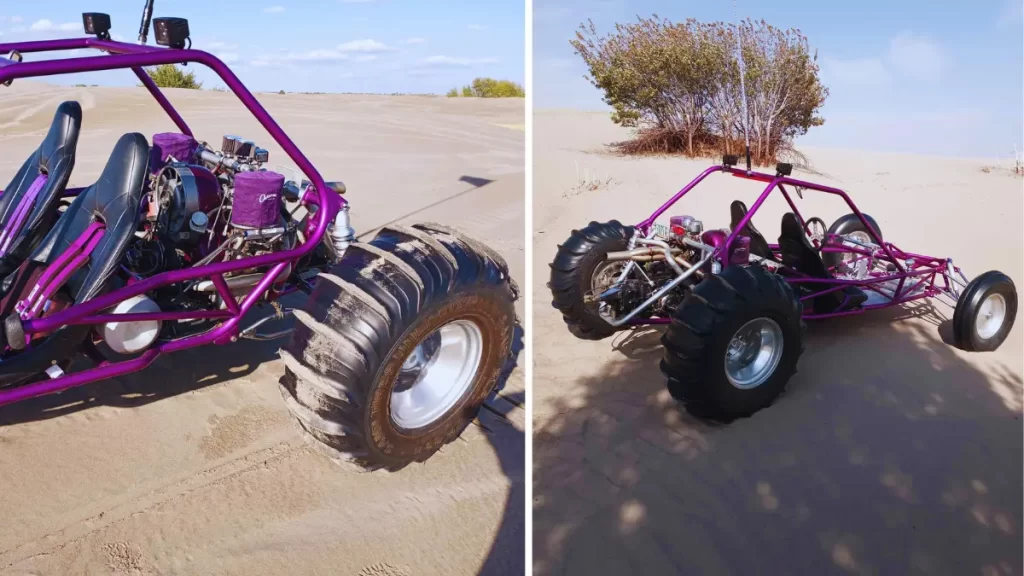If you’re into off-road riding in sand dunes or desert terrain, you’ve likely seen buggy-like vehicles with oversized rear wheels that seem to float across the sand at lightning fast speeds.
Many of these types of vehicles are called sand rails, and they’re some of the best all around sand-based vehicles you’ll find.
But are these vehicles limited to driving off-road?
One of the most commonly asked questions about sand rails is around how to make them street legal.
We’ll cover the steps you’ll need to take to make your sand rail street-legal, along with providing an overview of:
- What a sand rail is
- How sand rails are built
- Their off-road capabilities
- How they differ from dune buggies
- What makes them so popular among outdoor enthusiasts

The Sand Rail
The Sand Rail is a lightweight off-road vehicle designed for riding in sand dunes and desert terrain.
It is also many times referred to as a dune buggy, though there are technically some distinct differences between the two.
Sand rails get their name from the tubular steel rails that make up most of their frames and encircle the rest of their components.
These dune riders got their start in the late 1960’s, after similar off-road vehicles such as dune buggies and the Meyers Manx had begun to explode in popularity in the years before.

Off-road enthusiasts who mainly rode sand dunes and desert terrain realized they would benefit from a more powerful but lightweight vehicle with a similar design, and began building simplified versions of the dune buggy on their own.
Thus, the sand rail was born. And it wasn’t long before their popularity grew to the point that they would outnumber most other sand-based off-road vehicles on any given day at the sand dunes or on desert trails.
These days, sand rails are easily the most prevalent vehicle you’ll find riding in the dunes or desert.
Design Of The Sand Rail
One factor that makes sand rails so popular among outdoor enthusiasts is their simple design.
Made specifically for use in sandy terrain, these vehicles need to remain light and maneuverable to avoid sinking into and getting stuck in the sand.
They typically only weigh between 700 and 1,400 lbs in total.
The majority of sand rails feature a tube frame design that enables a roll cage to be installed rather easily, along with a floor pan.
Outside of that, there is usually not much else in the way of body work, doors, windows, or windshields for protection from sand and other outside elements, making goggles or a visored helmet essential for riders.

Sandrails are usually equipped with a rear-mounted engine, which helps balance the vehicle by keeping most of the weight in the backend to help avoid the front tires from digging into the sand.
The engine location also helps prevent sand and heat from being blown back into the driver’s face by the engine fan.
These vehicles are also usually equipped with some type of smooth flotation tires up front, which make for less drag and more speed in the sand.
In the rear, sand rails are equipped with bigger paddle tires with aggressive tread slots. These paddle tires scoop down into the sand to provide maximum traction and performance.

Most sand rails sit down low so they can make tight turns on steep sand dunes, with their flat bottoms able to slide across the sand pretty easily when coming in contact.
Due to the simple design of these vehicles, the overwhelming majority of them are not deemed street legal initially.
However, owners can make some modifications to potentially change that.
Street Legal Sand Rail
Whether or not your sand rail can be legally driven on public roads comes down to a few different factors, with the main one being the state you’re located in.
While there are a number of states that will deem your sand rail street legal provided you’ve made a number of necessary modifications, there are plenty of others that simply will not allow for a sand rail to ever legally be driven on a public road.
You’ll need to check the laws and regulations in your state to confirm whether or not making your vehicle street legal is possible.
States such as Arizona, Colorado, Texas, and Nevada are a few examples of states where it is possible to obtain street-legal status for a sand rail.
Making A Sand Rail Street Legal
The modifications you’ll need to make to obtain street-legal status for your sand rail vary from state to state, but these are some of the most commonly required safety features:
- Headlights
- Tail lights
- Brake lights
- Turn signals
- Seat belts
- Rear view mirror
- Parking/emergency brake
- Brakes on at least two wheels
- Windshield
- Windshield wipers
While most sand rails typically don’t have a windshield, some owners have cut and made a portable plexiglass windshield for their vehicle so they can remove it when not driving on the road.

Once you’ve made the needed modifications to your sand rail, you’ll need to have it inspected so that it can be assigned a VIN number.
Your sand rail will need to have a floor pan or some sort of flooring to pass this inspection. Those whose vehicles sit on the frame of a once street legal vehicle will have an easier time with this.
Upon passing this inspection, you’ll still need to do the following:
- Register your vehicle
- Title your vehicle
- Insure your vehicle
- Put a license plate on your vehicle
Lastly, you may need to ensure that your sand rail’s engine meets emissions requirements. These requirements will vary by state as well.
Building A Sand Rail
There are several approaches to consider when building a sand rail.
The easiest way is to start with the essential parts from a “donor car” and build up from there. That way, you already have components such as the chassis and suspension in place.
You can also build up from scratch, using one of the many different sand rail kits available for purchase.
These sand rail kits range from complete kits that include every component you need, including a chassis and suspension system, to kits that only include a few parts that you could use to build on top of a donor car.
Suspension Systems
One of the most important considerations when building a sand rail is the type of suspension system to use.
Your decision will depend upon what kind of riding you plan to do.
If you’ll spend most of your time doing some pretty serious off-road riding, a link-and-kingpin front suspension and swing axle rear suspension combination is likely the best fit.
While this suspension set-up won’t provide the most comfortable ride, it will stand up well to the abuses of off-road riding.
If you don’t plan to do as much serious off-road riding in your sand rail and may use it for more street riding, the ball-joint front suspension and independent rear suspension combination will likely be the best fit.
This suspension set-up offers a more comfortable ride, along with better steering and control. But they don’t hold up well to serious off-road riding.
Engines
Sand rails are built with a number of different types of engines.
The air-cooled Volkswagen engine was the most popular option in early sand rail models, but options have expanded to engines from the likes of Subaru, Chevy, and Honda among others.
As sand rails spend most of their time in the sand, and sand is known to zap vehicles of their power, some owners have even chosen to upgrade their engines to help offset this.
Performance modifications like turbochargers, high performance cylinder heads, racing carburetors, fuel injection, and bigger pistons are just a few of the upgrades owners are known to turn to.
Types of Sand Rails
Sand rails come in many different styles and sizes, with owners able to customize the engine type, frame, and number of seats to their liking.
But sand rails do generally fall into one of three main types depending upon the specific front-end suspension used.
Long Travel Sand Rails
The most modern form of sand rail is the Long Travel design. Long Travel sand rails are built with A-Arms and a coilover suspension.
They feature extra long travel in the front and rear, an extra long wheelbase, and the most ground clearance of the three types of sand rails.
Mid Travel Sand Rails
Mid Travel sand rails are another modern style. They are built using A-Arms but a stock suspension rather than coilovers.
They feature slightly less travel and ground clearance than the Long Travel builds.
VW Sand Rails
VW Sand Rails, also referred to as “classic” or “old school” sand rails, refer to those sand rails that are built using a “donor” car in the form of a classic Volkswagen Beetle and use the Volkswagen’s original front end and suspension along with L-Beams.
This was the most common sand rail build when they first appeared on the scene back in the late 60’s on into the 70’s.
While there are a number of VW sand rails out there that were made using the chassis, pan, and suspension of a VW Beetle, it is much more common for dune buggies and the Meyers Manx to be built this way.
Sand Rails Vs. Dune Buggies
It is very common for folks to refer to sand rails as dune buggies and vice versa. But while the sand rail is a buggy-style vehicle, it is not a dune buggy.
Dune buggies are typically modified from an existing vehicle and feature an open chassis. Sand rails are mostly built with an open frame, tubular chassis and come installed with a roll cage similar to a UTV or side by side.
With their more open build styles, sand rails also usually don’t feature body panels, windows, or doors while dune buggies more often are built with some of these components.
Dune buggies are also usually limited in the type and size of tires they can be fitted with due to their design having the wheels closer to the chassis with limited wheel well space.
This is not so for most sand rails, with their more open builds allowing for the fitment of pretty much any size of tires.
Since dune buggies are usually built up using the chassis, suspensions, and other components of street-legal vehicles, they are typically easier to be deemed street legal than sand rails.
Conclusion
Since their inception in the late 1960’s, sand rails have grown to be one of the most popular off-road vehicles to race and ride in sand dunes and desert terrain today.
For more off-road vehicles that perform admirably in the sand, check out the following before you hit the dunes:


